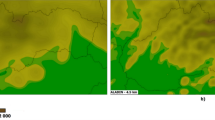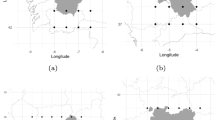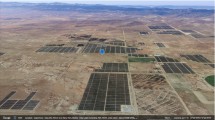Abstract
Despite the maturity of ensemble numerical weather prediction (NWP), the resulting forecasts are still, more often than not, under-dispersed. As such, forecast calibration tools have become popular. Among those tools, quantile regression (QR) is highly competitive in terms of both flexibility and predictive performance. Nevertheless, a long-standing problem of QR is quantile crossing, which greatly limits the interpretability of QR-calibrated forecasts. On this point, this study proposes a non-crossing quantile regression neural network (NCQRNN), for calibrating ensemble NWP forecasts into a set of reliable quantile forecasts without crossing. The overarching design principle of NCQRNN is to add on top of the conventional QRNN structure another hidden layer, which imposes a non-decreasing mapping between the combined output from nodes of the last hidden layer to the nodes of the output layer, through a triangular weight matrix with positive entries. The empirical part of the work considers a solar irradiance case study, in which four years of ensemble irradiance forecasts at seven locations, issued by the European Centre for Medium-Range Weather Forecasts, are calibrated via NCQRNN, as well as via an eclectic mix of benchmarking models, ranging from the naïve climatology to the state-of-the-art deep-learning and other non-crossing models. Formal and stringent forecast verification suggests that the forecasts post-processed via NCQRNN attain the maximum sharpness subject to calibration, amongst all competitors. Furthermore, the proposed conception to resolve quantile crossing is remarkably simple yet general, and thus has broad applicability as it can be integrated with many shallow- and deep-learning-based neural networks.
Similar content being viewed by others
Change history
29 April 2024
The font color for equations (3) has been corrected.
References
Bauer, P., A. Thorpe, and G. Brunet, 2015: The quiet revolution of numerical weather prediction. Nature, 525, 47–55, https://doi.org/10.1038/nature14956.
Bondell, H. D., B. J. Reich, and H. Wang, 2010: Noncrossing quantile regression curve estimation. Biometrika, 97, 825–838, https://doi.org/10.1093/biomet/asq048.
Bremnes, J. B., 2004: Probabilistic forecasts of precipitation in terms of quantiles using NWP model output. Mon. Wea. Rev., 132, 33–347, https://doi.org/10.1175/1520-0493(2004)132<0338:PFOPIT>2.0.CO;2.
Bremnes, J. B., 2019: Constrained quantile regression splines for ensemble postprocessing. Mon. Wea. Rev., 147, 1769–1780, https://doi.org/10.1175/MWR-D-18-0420.1.
Bremnes, J. B., 2020: Ensemble postprocessing using quantile function regression based on neural networks and Bernstein polynomials. Mon. Wea. Rev., 148 (1), 403–414, https://doi.org/10.1175/MWR-D-19-0227.1.
Cannon, A. J., 2011: Quantile regression neural networks: Implementation in R and application to precipitation downscaling. Computers & Geosciences, 37, 1277–1284, https://doi.org/10.1016/j.cageo.2010.07.005.
Cannon, A. J., 2018: Non-crossing nonlinear regression quantiles by monotone composite quantile regression neural network, with application to rainfall extremes. Stochastic Environmental Research and Risk Assessment, 32 (11), 3207–3225, https://doi.org/10.1007/s00477-018-1573-6.
Chernozhukov, V., I. Fernández-Val, and A.Y. Galichon, 2010: Quantile and probability curves without crossing. Econometrica, 78, 1093–1125, https://doi.org/10.3982/ECTA7880.
Demaeyer, J., J. Bhend, S. Lerch, C. Primo, B. van Schaeybroeck, A. Atencia, Z. Ben Bouallègue, J. Chen, M. Dabernig, G. Evans, J. Faganeli Pucer, B. Hooper, N. Horat, D. Jobst, J. Merše, P. Mlakar, A. Möller, O. Mestre, M. Taillardat, and S. Vannitsem, 2023: The EUPPBench postprocessing benchmark dataset v1.0. Earth System Science Data, 15, 2635–2653, https://doi.org/10.5194/essd-15-2635-2023.
Dimitriadis, T., T. Gneiting, and A. I. Jordan, 2021: Stable reliability diagrams for probabilistic classifiers. Proceedings of the National Academy of Sciences of the United States of America, 118, e2016191118, https://doi.org/10.1373/anas.2016191118.
Doubleday, K., V. van Scyoc Hernandez, and B. M. Hodge, 2020: Benchmark probabilistic solar forecasts: Characteristics and recommendations. Solar Energy, 206, 52–67, https://doi.org/10.1016/j.solener.2020.05.051.
El Adlouni, S., and I. Baldé, 2019: Bayesian non-crossing quantile regression for regularly varying distributions. Journal of Statistical Computation and Simulation, 89 (5), 884–898, https://doi.org/10.1080/00949655.2019.1573899.
Fortin, V., A. C. Favre, and M. Saïd, 2006: Probabilistic forecasting from ensemble prediction systems: Improving upon the best-member method by using a different weight and dressing kernel for each member. Quart. J. Roy. Meteor. Soc., 132 (617), 1349–1369, https://doi.org/10.1256/qj.05.167.
Gasthaus, J., K. Benidis, Y. Wang, S. S. Rangapuram, D. Salinas, V. Flunkert, and T. Januschowski, 2019: Probabilistic forecasting with spline quantile function RNNs. Proc. 22nd Int. Conf. on Artificial Intelligence and Statistics, Naha, Okinawa, Japan, 1901–1910.
Gneiting, T., and A. E. Raftery, 2007: Strictly proper scoring rules, prediction, and estimation. Journal of the American Statistical Association, 102, 359–378, https://doi.org/10.1198/016214506000001437.
Gneiting, T., and M. Katzfuss, 2014: Probabilistic forecasting. Annual Review of Statistics and Its Application, 1 (1), 125–151, https://doi.org/10.1146/annurev-statistics-062713-085831.
Gneiting, T., F. Balabdaoui, and A. E. Raftery, 2007: Probabilistic forecasts, calibration and sharpness. Journal of the Royal Statistical Society Series B: Statistical Methodology, 69, 243–268, https://doi.org/10.1111/j.1467-9868.2007.00587.x.
Gneiting, T., S. Lerch, and B. Schulz, 2023: Probabilistic solar forecasting: Benchmarks, post-processing, verification. Solar Energy, 252, 72–80, https://doi.org/10.1016/j.solener2022.12.054.
Gneiting, T., A. E. Raftery, A. H. Westveld, and T. Goldman, 2005: Calibrated probabilistic forecasting using ensemble model output statistics and minimum CRPS estimation. Mon. Wea. Rev., 113 (5), 1098–1118, https://doi.org/10.1175/MWR2904.1.
Guo, S., Y. Han, and Q. Wang, 2021: Better nonparametric confidence intervals via robust bias correction for quantile regression. Stat, 10, e370, https://doi.org/10.1002/sta4.370.
Hersbach, H., 2000: Decomposition of the continuous ranked probability score for ensemble prediction systems. Wea. Forecasting, 15, 559–570, https://doi.org/10.1175/1520-0434(2000)015<0559:DOTCRP>2.0.CO;2.
Huber, P. J., 1964: Robust estimation of a location parameter. The Annals of Mathematical Statistics, 35 (1), 73–101, https://doi.org/10.1214/aoms/1177703732.
Kithinji, M. M., P. N. Mwita, and A. O. Kube, 2021: Adjusted extreme conditional quantile autoregression with application to risk measurement. Journal of Probability and Statistics, 2021, 6697120, https://doi.org/10.1155/2021/6697120.
Koenker, R., and G. Bassett Jr., 1978: Regression quantiles. Econometrica, 46, 33–50, https://doi.org/10.2307/1913643.
Kottek, M., J. Grieser, C. Beck, B. Rudolf, and F. Rubel, 2006: World map of the Köppen-Geiger climate classification updated. Meteor. Z., 15, 259–263, https://doi.org/10.1127/0941-2948/2006/0130.
Lauret, P., M. David, and P. Pinson, 2019: Verification of solar irradiance probabilistic forecasts. Solar Energy, 194, 254–271, https://doi.org/10.1016/j.solener.2019.10.041.
Liu, Y., and Y. Wu, 2009: Stepwise multiple quantile regression estimation using non-crossing constraints. Statistics and Its Interface, 2 (3), 299–310, https://doi.org/10.4310/SII.2009.v2.n3.a4.
Mayer, M. J., and D. Yang, 2023a: Calibration of deterministic NWP forecasts and its impact on verification. International Journal of Forecasting, 39 (2), 981–991, https://doi.org/10.1016/j.ijforecast.2022.03.008.
Mayer, M. J., and D. Yang, 2023b: Pairing ensemble numerical weather prediction with ensemble physical model chain for probabilistic photovoltaic power forecasting. Renewable and Sustainable Energy Reviews, 175, 113171, https://doi.org/10.1016/j.rser.2023.113171.
Meinshausen, N., 2006: Quantile regression forests. The Journal of Machine Learning Research, 7, 983–999.
Moon, S. J., J. J. Jeon, J. S. H. Lee, and Y. Kim, 2021: Learning multiple quantiles with neural networks. Journal of Computational and Graphical Statistics, 30, 1238–1248, https://doi.org/10.1080/10618600.2021.1909601.
Murphy, A. H., 1988: Skill scores based on the mean square error and their relationships to the correlation coefficient. Mon. Wea. Rev., 116, 2417–2424, https://doi.org/10.1175/1520-0493(1988)116<2417:SSBOTM>2.0.CO;2.
Pinson, P., P. McSharry, and H. Madsen, 2010: Reliability diagrams for non-parametric density forecasts of continuous variables: Accounting for serial correlation. Quart. J. Roy. Meteor. Soc., 136, 77–90, https://doi.org/10.1002/qj.559.
Pinson, P., H. A. Nielsen, J. K. Møller, H. Madsen, and G. N. Kariniotakis, 2007: Non- parametric probabilistic forecasts of wind power: Required properties and evaluation. Wind Energy, 10, 497–516, https://doi.org/10.1002/we.230.
Raftery, A. E., T. Gneiting, F. Balabdaoui, and M. Polakowski, 2005: Using Bayesian model averaging to calibrate forecast ensembles. Mon. Wea. Rev., 133 (5), 1155–1174, https://doi.org/10.1175/MWR2906.1.
Rasp, S., and S. Lerch, 2018: Neural networks for postprocessing ensemble weather forecasts. Mon. Wea. Rev., 146, 3885–3900, https://doi.org/10.1175/MWR-D-18-0187.1.
Reshef, D. N., Y.A. Reshef, H. K. Finucane, S. R. Grossman, G. McVean, P. J. Turnbaugh, E. S. Lander, M. Mitzenmacher, and P. C. Sabeti, 2011: Detecting novel associations in large data sets. Science, 334 (6062), 1518–1524, https://doi.org/10.1126/science.1205438.
Roulston, M. S., and L. A. Smith, 2003: Combining dynamical and statistical ensembles. Tellus A: Dynamic Meteorology and Oceanography, 55 (1), 16–30, https://doi.org/10.3402/tellusa.v55i1.12082.
Schulz, B., and S. Lerch, 2022: Machine learning methods for postprocessing ensemble forecasts of wind gusts: A systematic comparison. Mon. Wea. Rev., 150, 235–257, https://doi.org/10.1175/MWR-D-21-0150.1.
Schulz, B., M. El Ayari, S. Lerch, and S. Baran, 2021: Post-processing numerical weather prediction ensembles for probabilistic solar irradiance forecasting. Solar Energy, 220, 1016–1031, https://doi.org/10.1016/j.solener.2021.03.023.
Seeger, M., 2004: Gaussian processes for machine learning. International Journal of Neural Systems, 14 (2), 69–106, https://doi.org/10.1142/S0129065704001899.
Sperati, S., S. Alessandrini, and L. Delle Monache, 2016: An application of the ECMWF Ensemble Prediction System for short-term solar power forecasting. Solar Energy, 133, 437–450, https://doi.org/10.1016/j.solener.2016.04.016.
Taillardat, M., O. Mestre, M. Zamo, and P. Naveau, 2016: Calibrated ensemble forecasts using quantile regression forests and ensemble model output statistics. Mon. Wea. Rev., 144, 2375–2393, https://doi.org/10.1175/MWR-D-15-0260.1.
Taylor, J. W., 2000: A quantile regression neural network approach to estimating the conditional density of multiperiod returns. Journal of Forecasting, 19 (4), 299–311, https://doi.org/10.1002/1099-131X(200007)19:4<299::AID-FOR775>3.0.CO;2-V.
Vannitsem, S., D. S. Wilks, and J. Messner, 2018: Statistical Postprocessing of Ensemble Forecasts. Elsevier.
Vannitsem, S., J. B. Bremnes, J. Demaeyer, G. R. Evans, J. Flowerdew, S. Hemri, S. Lerch, N. Roberts, S. Theis, A. Atencia, Z. Ben Bouallégue, J. Bhend, M. Dabernig, L. De Cruz, L. Hieta, O. Mestre, L. Moret, I. O. Plenković, M. Schmeits, M. Taillardat, J. van den Bergh, B. van Schaeybroeck, K. Whan, and J. Ylhaisi, 2021: Statistical postprocessing for weather forecasts: Review, challenges, and avenues in a big data world. Bull. Amer. Meteor. Soc., 102, E681–E699, https://doi.org/10.1175/BAMS-D-19-0308.1.
Wang, W., D. Yang, T. Hong, and J. Kleissl, 2022: An archived dataset from the ECMWF Ensemble Prediction System for probabilistic solar power forecasting. Solar Energy, 248, 64–75, https://doi.org/10.1016/j.solener.2022.10.062.
Wang, X., and C. H. Bishop, 2005: Improvement of ensemble reliability with a new dressing kernel. Quart. J. Roy. Meteor. Soc., 131 (607), 965–986, https://doi.org/10.1256/qj.04.120.
Wang, Y., D. Gan, M. Sun, N. Zhang, Z. Lu, and C. Kang, 2019: Probabilistic individual load forecasting using pinball loss guided LSTM. Applied Energy, 235, 10–20, https://doi.org/10.1016/j.apenergy.2018.10.078.
Wei, Y., and R. J. Carroll, 2009: Quantile regression with measurement error. Journal of the American Statistical Association, 104 (487), 1129–1143, https://doi.org/10.1198/jasa.2009.tm08420.
Yagli, G. M., D. Yang, and D. Srinivasan, 2019: Automatic hourly solar forecasting using machine learning models. Renewable and Sustainable Energy Reviews, 105, 487–498, https://doi.org/10.1016/j.rser.2019.02.006.
Yagli, G. M., D. Yang, and D. Srinivasan, 2020: Ensemble solar forecasting using data-driven models with probabilistic post-processing through GAMLSS. Solar Energy, 208, 612–622, https://doi.org/10.1016/j.solener.2020.07.040.
Yagli, G. M., D. Yang, and D. Srinivasan, 2022: Ensemble solar forecasting and post-processing using dropout neural network and information from neighboring satellite pixels. Renewable and Sustainable Energy Reviews, 155, 111909, https://doi.org/10.1016/j.rser.2021.111909.
Yang, D., 2017: On adding and removing sensors in a solar irradiance monitoring network for areal forecasting and PV system performance evaluation. Solar Energy, 155, 1417–1430, https://doi.org/10.1016/j.solener.2017.07.061.
Yang, D., 2018a: A correct validation of the National Solar Radiation Data Base (NSRDB). Renewable and Sustainable Energy Reviews, 97, 152–155, https://doi.org/10.1016/j.rser.2018.08.023.
Yang, D., 2018b: SolarData: An R package for easy access of publicly available solar datasets. Solar Energy, 171, A3–A12, https://doi.org/10.1016/j.solener.2018.06.107.
Yang, D., 2019a: Post-processing of NWP forecasts using ground or satellite-derived data through kernel conditional density estimation. Journal of Renewable and Sustainable Energy, 11 (2), 026101, https://doi.org/10.1063/1.5088721.
Yang, D., 2019b: A universal benchmarking method for probabilistic solar irradiance forecasting. Solar Energy, 184, 410–416, https://doi.org/10.1016/j.solener.2019.04.018.
Yang, D., 2019c: Ultra-fast analog ensemble using kd-tree. Journal of Renewable and Sustainable Energy, 11 (5), 053703, https://doi.org/10.1063/1.15124711.
Yang, D., 2020a: Ensemble model output statistics as a probabilistic site-adaptation tool for solar irradiance: A revisit. Journal of Renewable and Sustainable Energy, 12 (3), 036101, https://doi.org/10.1063/5.0010003.
Yang, D., 2020b: Choice of clear-sky model in solar forecasting. Journal of Renewable and Sustainable Energy, 12 (2), 026101, https://doi.org/10.1063/5.0003495.
Yang, D., 2020c: Ensemble model output statistics as a probabilistic site-adaptation tool for satellite-derived and reanalysis solar irradiance. Journal of Renewable and Sustainable Energy, 12 (1), 016102, https://doi.org/10.1063/L5134731.
Yang, D., 2022a: Correlogram, predictability error growth, and bounds of mean square error of solar irradiance forecasts. Renewable and Sustainable Energy Reviews, 167, 112736, https://doi.org/10.1016/j.rser.2022.112736.
Yang, D., 2022b: Estimating 1-min beam and diffuse irradiance from the global irradiance: A review and an extensive worldwide comparison of latest separation models at 126 stations. Renewable and Sustainable Energy Reviews, 159, 112195, https://doi.org/10.1016/j.rser.2022.112195.
Yang, D., and R. Perez, 2019: Can we gauge forecasts using satellite-derived solar irradiance?. Journal of Renewable and Sustainable Energy, 11 (2), 023704, https://doi.org/10.1063/1.5087588.
Yang, D., and J. M. Bright, 2020: Worldwide validation of 8 satellite-derived and reanalysis solar radiation products: A preliminary evaluation and overall metrics for hourly data over 27 years. Solar Energy, 210, 3–19, https://doi.org/10.1016/j.solener.2020.04.016.
Yang, D., and D. van der Meer, 2021: Post-processing in solar forecasting: Ten overarching thinking tools. Renewable and Sustainable Energy Reviews, 140, 110735, https://doi.org/10.1016/j.rser.2021.110735.
Yang, D., and C. A. Gueymard, 2021: Probabilistic post-processing of gridded atmospheric variables and its application to site adaptation of shortwave solar radiation. Solar Energy, 225, 427–443, https://doi.org/10.1016/j.solener.2021.05.050.
Yang, D., D. van der Meer, and J. Munkhammar, 2020: Probabilistic solar forecasting benchmarks on a standardized dataset at Folsom, California. Solar Energy, 206, 628–639, https://doi.org/10.1016/j.solener.2020.05.020.
Yang, D., W. Wang, and T. Hong, 2022c: A historical weather forecast dataset from the European Centre for Medium-Range Weather Forecasts (ECMWF) for energy forecasting. Solar Energy, 232, 263–274, https://doi.org/10.1016/j.solener.2021.12.011.
Yang, D., W. Wang, J. M. Bright, C. Voyant, G. Notton, G. Zhang, and C. Lyu, 2022a: Verifying operational intra-day solar forecasts from ECMWF and NOAA. Solar Energy, 236, 743–755, https://doi.org/10.1016/j.solener.2022.03.004.
Yang, D., W. Wang, C. A. Gueymard, T. Hong, J. Kleissl, J. Huang, M. J. Perez, R. Perez, J. M. Bright, X. Xia, D. van der Meer, and I. M. Peters, 2022b: A review of solar forecasting, its dependence on atmospheric sciences and implications for grid integration: Towards carbon neutrality. Renewable and Sustainable Energy Reviews, 161, 112348, https://doi.org/10.1016/j.rser.2022.112348.
Zou, R., M. Song, Y. Wang, J. Wang, K. Yang, and M. Affenzeller, 2022: Deep non-crossing probabilistic wind speed forecasting with multi-scale features. Energy Conversion and Management, 257, 115433, https://doi.org/10.1016/j.enconman.2022.115433.
Acknowledgements
This work is supported by the National Natural Science Foundation of China (Project No. 42375192) and the China Meteorological Administration Climate Change Special Program (CMA-CCSP; Project No. QBZ202315).
Sebastian LERCH acknowledges support by the Vector Stiftung through the Young Investigator Group “Artificial Intelligence for Probabilistic Weather Forecasting.”
The ECMWF operational forecast and analysis data used in this study were downloaded from the ECMWF Meteorological Archival and Retrieval System (MARS) in 2022. Access to the ECMWF archived data was provided by ECMWF’s Data Services. Special thanks go to Emma PIDDUCK, Ruth COUGHLAN, and Ilaria PARODI from the ECMWF’s Data Services team, for their swift communication regarding data access.
Author information
Authors and Affiliations
Corresponding authors
Additional information
This paper is a contribution to the special issue on AI Applications in Atmospheric and Oceanic Science: Pioneering the Future.
Article Highlights
• A non-crossing quantile regression neural network (NCQRNN) is proposed.
• NCQRNN is utilized to calibrate ensemble weather forecasts.
• The CORP reliability diagram is employed to evaluate the predictive reliability.
Rights and permissions
About this article
Cite this article
Song, M., Yang, D., Lerch, S. et al. Non-crossing Quantile Regression Neural Network as a Calibration Tool for Ensemble Weather Forecasts. Adv. Atmos. Sci. (2024). https://doi.org/10.1007/s00376-023-3184-5
Received:
Revised:
Accepted:
Published:
DOI: https://doi.org/10.1007/s00376-023-3184-5




